Comparing the Effect of Chemical and Biol Fertilization on the Fruit Yield and Selected Traits of Greenhouse-Grown Cucumber (Cucumis sativus L.) †
Abstract
1. Introduction
2. Materials and Methods
- Biol30: 3% biol applied every 30 days;
- Biol70: 7% biol applied every 30 days;
- Nitro: Nitrogen adjusted fertilization 1.9 kg urea applied in three split applications;
- Comp: Complete fertilization with 2 kg Ca(NO3)2, 1.6 kg MgSO4, 0.8 kg (NH4)2HPO4, 1.6 kg KNO3, and 1.6 kg urea.
2.1. Data Collection
2.2. Statistical Analysis
3. Results
4. Discussion
5. Conclusions
Author Contributions
Funding
Institutional Review Board Statement
Informed Consent Statement
Data Availability Statement
Acknowledgments
Conflicts of Interest
References
- Resh, H.M. Hydroponic Food Production: A Definitive Guidebook for the Advanced Home Gardener and the Commercial Hydroponic Grower; CRC Press: Boca Raton, FL, USA, 2022; ISBN 1003133258. [Google Scholar]
- Saeed, K.S.; Abdulla Ahmed, S.; Hassan, I.A.; Ahmed, H. Effect of Bio-Fertilizer and Chemical Fertilizer on Growth and Yield in Cucumber (Cucumis sativus) in Green House Condition. Pak. J. Biol. Sci. 2015, 18, 129–134. [Google Scholar]
- Savci, S. Investigation of Effect of Chemical Fertilizers on Environment. Apcbee Procedia 2012, 1, 287–292. [Google Scholar] [CrossRef]
- Chen, C.; Lv, Q.; Tang, Q. Impact of Bio-Organic Fertilizer and Reduced Chemical Fertilizer Application on Physical and Hydraulic Properties of Cucumber Continuous Cropping Soil. Biomass Convers. Biorefinery 2024, 14, 921–930. [Google Scholar] [CrossRef]
- Barragán-Ocaña, A.; del-Valle-Rivera, M.d.C. Rural Development and Environmental Protection through the Use of Biofertilizers in Agriculture: An Alternative for Underdeveloped Countries? Technol. Soc. 2016, 46, 90–99. [Google Scholar] [CrossRef]
- Dominguez Hernandez, M.E.; Dominguez-Hernandez, E.; Martinez-Barrera, G.; Dominguez-Hernandez, A.; Zepeda-Bautista, R. Transdisciplinary Interventions to Improve the Sustainability of Maize Agroecosystems: A Case Study from Mexico. Transdiscipl. J. Eng. Sci. 2022, 13, 85–89. [Google Scholar] [CrossRef]
- Mahanty, T.; Bhattacharjee, S.; Goswami, M.; Bhattacharyya, P.; Das, B.; Ghosh, A.; Tribedi, P. Biofertilizers: A Potential Approach for Sustainable Agriculture Development. Environ. Sci. Pollut. Res. 2017, 24, 3315–3335. [Google Scholar] [CrossRef]
- Ritika, B.; Utpal, D. Biofertilizer, a Way towards Organic Agriculture: A Review. Afr. J. Microbiol. Res. 2014, 8, 2332–2343. [Google Scholar] [CrossRef]
- Álvarez Rodríguez, A.; Campo Costa, A.; Batista Ricardo, E.; Morales Miranda, A. Influencia del Humus por vía Foliar en el desarrollo vegetal del cultivo del Pepino (Cucumis sativus L.) en la Unidad Básica de Producción Cooperativa (UBPC) “El Jardín”, Municipio Holguín. Cuba. Ciencias Holguín 2010, 16, 1–10. [Google Scholar]
- Siura, S.; Barrios, F.; Delgado, J.; Dávila, S.; Chillet, M. Efectos Del Biol (Abono Orgánico) En La Producción de Hortalizas. In Vertientes del Pensamiento Agroecológico: Fundamentos y Aplicaciones Sociedad Científica Latinoamerica de Agroecología; Altieri, M., Ed.; SOCLA: Medellín, Colombia, 2009; pp. 289–304. [Google Scholar]
- Coletto, A.F.; Ferraz De Almeida, R.; Elias, J.; Mikhael, R.; Wendling, B.; Camargo, R. Chemical Attributes of Soil Fertirrigated with Biodigester Effluent of Swine Origin. Aust. J. Crop Sci. 2015, 9, 431–437. [Google Scholar]
- Southavong, S.; Preston, T.R.; Van Man, N. Effect of Biochar and Biodigester Effluent on Growth of Water Spinach (Ipomoea Aquatic) and Soil Fertility. Livest. Res. Rural. Dev. 2012, 24, 1–15. [Google Scholar]
- Borin, K.; Frankow-Lindberg, B.E. The Effects of Effluent from Biodigesters Loaded with Pig or Cow Manures on Soil Fertility and Forage Yield of Cassava Grown as a Perennial Crop. Biol. Agric. Hortic. 2006, 24, 91–104. [Google Scholar] [CrossRef]
- Bhunia, S.; Bhowmik, A.; Mallick, R.; Mukherjee, J. Agronomic Efficiency of Animal-Derived Organic Fertilizers and Their Effects on Biology and Fertility of Soil: A Review. Agronomy 2021, 11, 823. [Google Scholar] [CrossRef]
- Gámez, A.; De Gouviera, M.; Álvarez, W.; Pérez, H.; Carrillo, F.; Medina, S.; Silva, R. Efecto De La Fertilizacion Organica Con Biol Sobre La Productividad Del Pepino (Cucumis sativus) En Condiciones De Colinas Del Estado Guarico. In Proceedings of the 2o Congreso Venezolano de Ciencia, Tecnología e Innovación, Caracas, Venezuela, 7–10 November 2013. [Google Scholar]
- Callizaya Huanca, S.; Oviedo Farfan, J.E. Efecto de La Aplicación de Biol Sobre El Comportamiento Productivo Del Pepino (Cucumis sativus L.) Bajo Condiciones de Carpa Solar. [Bachelor’s Thesis, Higher University of San Andrés]. Available online: https://www.sidalc.net/search/Record/oai:localhost:8080:123456789-5720/Description (accessed on 21 May 2025).
- Halawa, N.; Waruwu, A.L.; Waruwu, F.A.M.; Gulo, E.K.S.; Lase, N.K. Analysis of the Effectiveness of Organic Fertilizer in Improving the Quality and Yield of Cucumber Crops. Flora J. Kaji. Ilmu Pertan. Perkeb. 2025, 2, 89–96. [Google Scholar] [CrossRef]
- Wang, S.; Bian, T.; Wu, T.; Zhang, Y.; Awais, M.; Fu, H.; Sun, Z. Co-Analysis of Cucumber Rhizosphere Metabolites and Microbial PLFAs under Excessive Fertilization in Solar Greenhouse. Front. Microbiol. 2022, 13, 1004836. [Google Scholar] [CrossRef]
- Çalık, B.; Sönmez, İ. The Effects of Liquid Biogas Digestate on Yield and Mineral Nutrition of Cucumber Growing in Greenhouse. Hortic. Stud. 2024, 41, 28–35. [Google Scholar] [CrossRef]
- Li, Y.; Mattson, N.S. Effect of Organic Fertilizer Source and Rate on Growth and Nutrient Leachate Profile of Greenhouse-Grown Cucumber. Horttechnology 2019, 29, 450–456. [Google Scholar] [CrossRef]
- Yagüe, M.R.; Lobo, M.d.C. Liquid Digestate Features as Fertilizer: Carbon Fractions, Phytotoxicity and Microbiological Analysis. Span. J. Soil Sci. 2020, 10, 248–256. [Google Scholar] [CrossRef]
- Celletti, S.; Lanz, M.; Bergamo, A.; Benedetti, V.; Basso, D.; Baratieri, M.; Cesco, S.; Mimmo, T. Evaluating the Aqueous Phase From Hydrothermal Carbonization of Cow Manure Digestate as Possible Fertilizer Solution for Plant Growth. Front. Plant Sci. 2021, 12, 687434. [Google Scholar] [CrossRef]
- Alvarado Carrillo, M.; Hernández Martínez, R.; Díaz Franco, A.; Alejandro Allende, F. Producción de Pimiento, Chile Habanero y Pepino en Casa de Malla, 1st ed.; SAGARPA-INIFAP: Río Bravo, Mexico, 2017; ISBN 9786073707428. [Google Scholar]
- Al-Zubaidi, J.; Mezhar, B. Effect of Bio-Digester Products on the Exchangeable, Nonexchangeable Potassium Values and Its Sorption in Soil. Biochem. Cell. Arch. 2021, 21, 2801. [Google Scholar]
- Rewe, M.K.; Muindi, E.; Ndiso, J.; Kinusu, K.; Mailu, S.; Njeru, P.; Thomas, R. Effect of Bioslurry from Fixed Dome and Tubular (Flexi) Biodigesters on Selected Soil Chemical Properties, Maize (Zea Mays) Growth, Yield and Quality. Int. J. Plant Soil Sci. 2021, 33, 158–171. [Google Scholar] [CrossRef]
- Siura, S.; Montes, I.; Dávila, S. Efecto Del Biol y La Rotación Con Abono Verde (Crotalaria Juncea) En La Producción de Espinaca (Spinacea Oleracea) Bajo Cultivo Orgánico. In Anales Científicos; Universidad Nacional Agraria La Molina: Lima, Peru, 2009; Volume 70, pp. 1–8. [Google Scholar]
- Wang, H.; Li, J.; Cheng, M.; Zhang, F.; Wang, X.; Fan, J.; Wu, L.; Fang, D.; Zou, H.; Xiang, Y. Optimal Drip Fertigation Management Improves Yield, Quality, Water and Nitrogen Use Efficiency of Greenhouse Cucumber. Sci. Hortic. 2019, 243, 357–366. [Google Scholar] [CrossRef]
- Ruiz, J.M.; Romero, L. Commercial Yield and Quality of Fruits of Cucumber Plants Cultivated under Greenhouse Conditions: Response to Increases in Nitrogen Fertilization. J. Agric. Food Chem. 1998, 46, 4171–4173. [Google Scholar] [CrossRef]
- Zhao, H.; Li, X.; Jiang, Y. Response of Nitrogen Losses to Excessive Nitrogen Fertilizer Application in Intensive Greenhouse Vegetable Production. Sustainability 2019, 11, 1513. [Google Scholar] [CrossRef]
- Subramanian, R.D.J.; Jayasingam, J.G.P. The Impact of Using Microalgae as Biofertilizer in Maize (Zea Mays L.). Waste Biomass Valorization 2019, 10, 1101–1110. [Google Scholar] [CrossRef]
- Isfahani, F.M.; Besharati, H. Effect of Biofertilizers on Yield and Yield Components of Cucumber. J. Biol. Earth Sci. 2012, 2, 83–92. [Google Scholar]
- Dinesh, R.; Srinivasan, V.; Hamza, S.; Manjusha, A. Short-Term Incorporation of Organic Manures and Biofertilizers Influences Biochemical and Microbial Characteristics of Soils under an Annual Crop [Turmeric (Curcuma Longa L.)]. Bioresour. Technol. 2010, 101, 4697–4702. [Google Scholar] [CrossRef]


| Treatment | Composition (N–P–K) |
|---|---|
| Comp | 425–125–310 |
| Biol30 | 0.125–1.57–52.32 |
| Biol70 | 0.292–3.5–122.08 |
| Nitro | 155–00–00 |
| Treatment | Total Production (kg) | Yield (kg/Bed) | Fruit Weight (kg) | Fruit Length (cm) |
|---|---|---|---|---|
| Comp | 269.35 | 33.67 a | 0.4036 b | 25.418 b |
| Biol30 | 235.08 | 29.38 a | 0.4424 ab | 27.171 a |
| Biol70 | 272.59 | 34.07 a | 0.4309 ab | 26.511 ab |
| Nitro | 247.55 | 30.94 a | 0.45327 a | 27.387 a |
| Pooled Standard Deviation | N.A. | 3.994 | 0.0458 | 1.378 |
Disclaimer/Publisher’s Note: The statements, opinions and data contained in all publications are solely those of the individual author(s) and contributor(s) and not of MDPI and/or the editor(s). MDPI and/or the editor(s) disclaim responsibility for any injury to people or property resulting from any ideas, methods, instructions or products referred to in the content. |
© 2025 by the authors. Licensee MDPI, Basel, Switzerland. This article is an open access article distributed under the terms and conditions of the Creative Commons Attribution (CC BY) license (https://creativecommons.org/licenses/by/4.0/).
Share and Cite
Ortiz-Romero, J.; Villafranco-Godinez, V.; Soriano-Gonzalez, I.F.; Fernandez-Mendiola, J.A.; Ortiz-Salgado, F.; Sotelo-Noguez, E.O.; Domínguez-Hernandez, M.E.; Dominguez-Hernandez, E. Comparing the Effect of Chemical and Biol Fertilization on the Fruit Yield and Selected Traits of Greenhouse-Grown Cucumber (Cucumis sativus L.). Biol. Life Sci. Forum 2025, 41, 8. https://doi.org/10.3390/blsf2025041008
Ortiz-Romero J, Villafranco-Godinez V, Soriano-Gonzalez IF, Fernandez-Mendiola JA, Ortiz-Salgado F, Sotelo-Noguez EO, Domínguez-Hernandez ME, Dominguez-Hernandez E. Comparing the Effect of Chemical and Biol Fertilization on the Fruit Yield and Selected Traits of Greenhouse-Grown Cucumber (Cucumis sativus L.). Biology and Life Sciences Forum. 2025; 41(1):8. https://doi.org/10.3390/blsf2025041008
Chicago/Turabian StyleOrtiz-Romero, Jorge, Vianney Villafranco-Godinez, Isaac Fernando Soriano-Gonzalez, Jonathan Alfredo Fernandez-Mendiola, Fernando Ortiz-Salgado, Edgar Orlando Sotelo-Noguez, Martha Elena Domínguez-Hernandez, and Elisa Dominguez-Hernandez. 2025. "Comparing the Effect of Chemical and Biol Fertilization on the Fruit Yield and Selected Traits of Greenhouse-Grown Cucumber (Cucumis sativus L.)" Biology and Life Sciences Forum 41, no. 1: 8. https://doi.org/10.3390/blsf2025041008
APA StyleOrtiz-Romero, J., Villafranco-Godinez, V., Soriano-Gonzalez, I. F., Fernandez-Mendiola, J. A., Ortiz-Salgado, F., Sotelo-Noguez, E. O., Domínguez-Hernandez, M. E., & Dominguez-Hernandez, E. (2025). Comparing the Effect of Chemical and Biol Fertilization on the Fruit Yield and Selected Traits of Greenhouse-Grown Cucumber (Cucumis sativus L.). Biology and Life Sciences Forum, 41(1), 8. https://doi.org/10.3390/blsf2025041008







